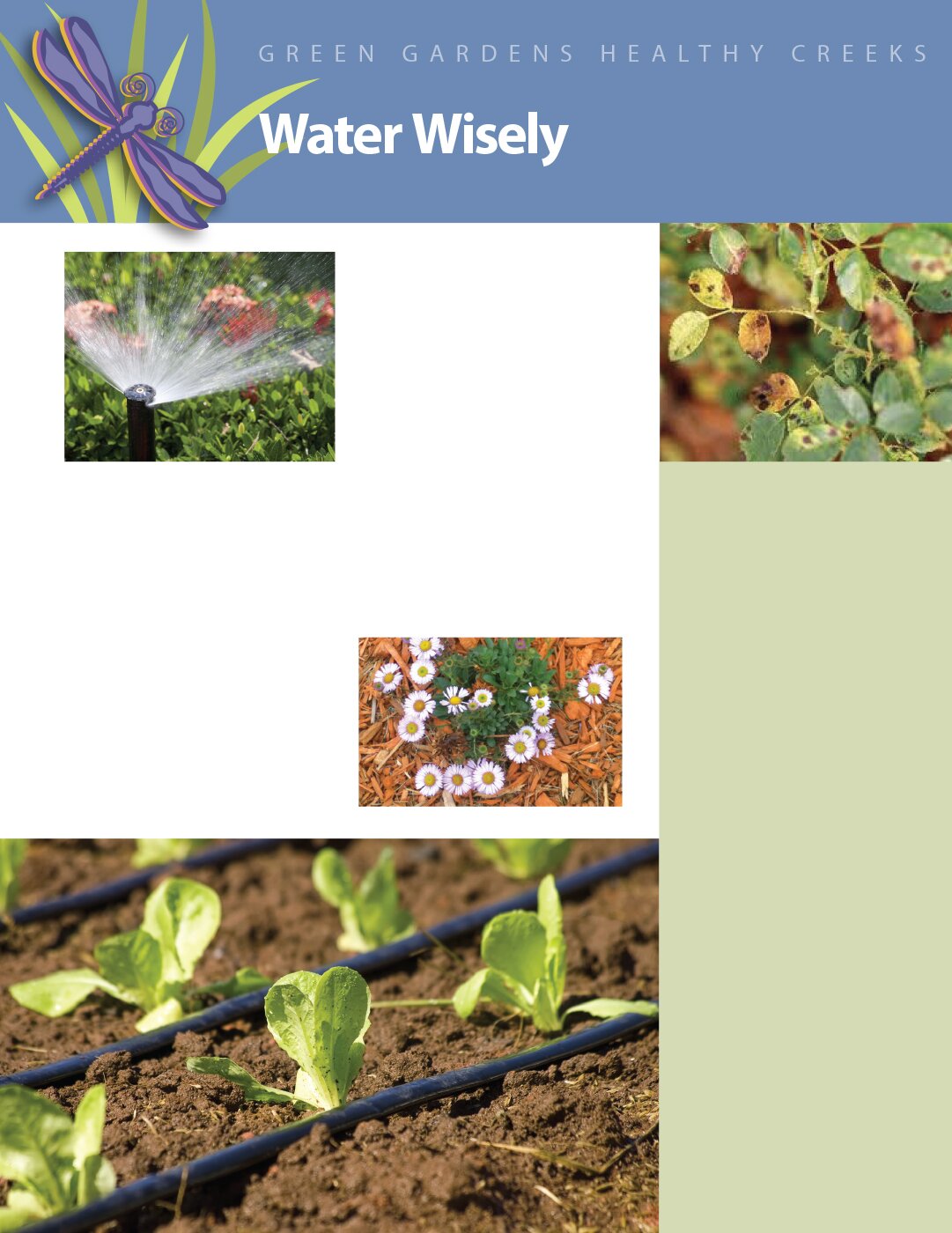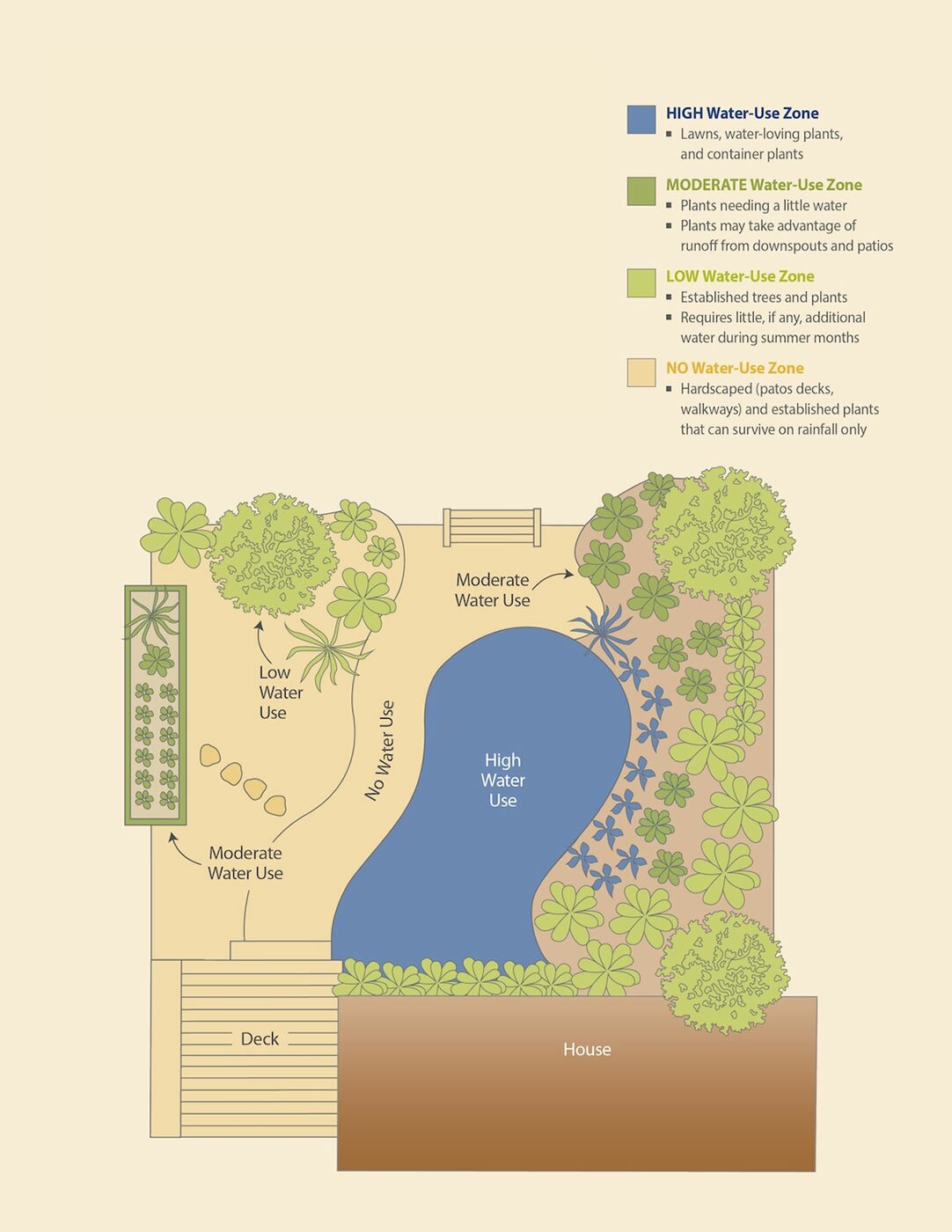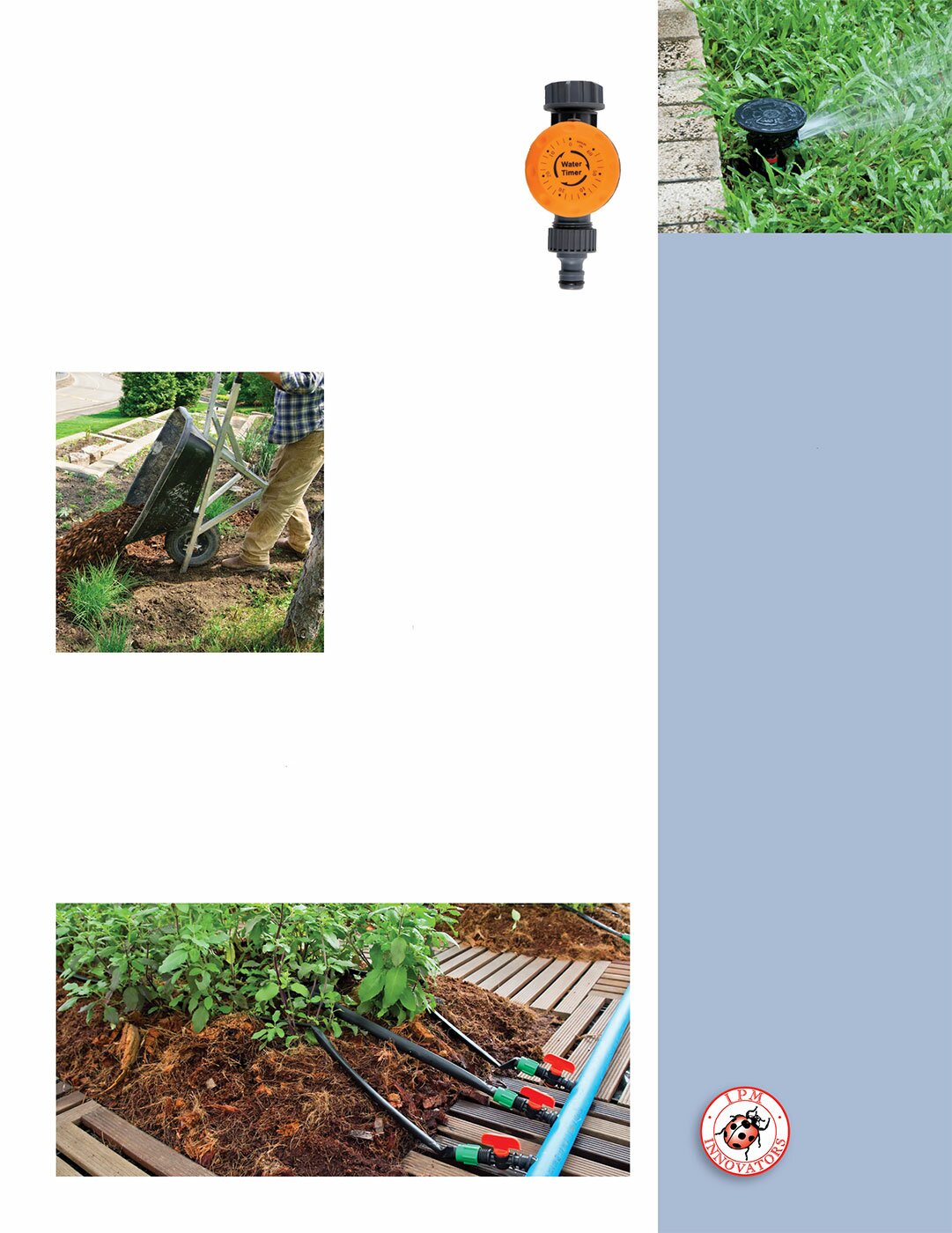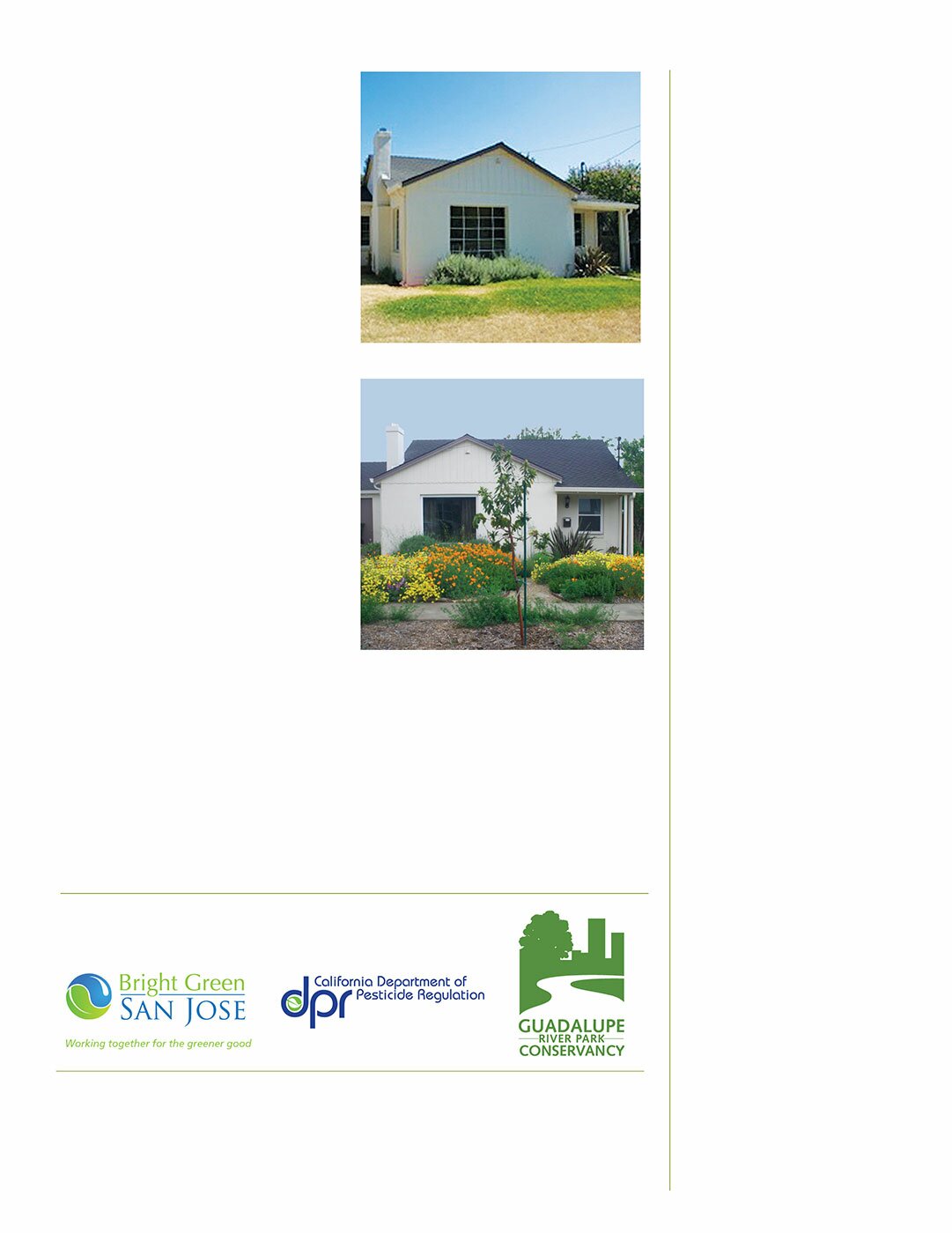
Use an efficient, effective watering system
An efficient watering system applies the right amount of water to the right parts of the garden at the right time. This conserves water and helps plants stay healthy to resist pests and diseases. Watering wisely entails:
- Watering according to plant needs, soil type, and sun exposure.
- Using a modern low-flow system like drip, with schedules matched to the plant needs, soil type, weather, and season.
- Avoiding runoff so sidewalks, driveways, and other non-target areas stay dry.
- Employing other sustainable practices such as mulching to retain soil moisture, water-wise plant selection, and use of alternative water supplies like collected rainwater or greywater.
Know Your Plants' Water Needs
Too much or too little water can weaken plants. Low water use plants include drought tolerant California natives or those adapted to a Mediterranean climate. Once established, these plants will stay healthy with little water. Medium water use plants include many ornamental shrubs including roses, vines, groundcovers, and perennials native to climates with significant summer rain. High water use plants include lawns, fruit trees, annual flower beds, vegetable gardens, and tropical gardens.
Downy Mildew or Black Spot on Rose Leaves
Efficient Watering to Avoid Pests and Diseases
Problem: Overwatering can suffocate roots and promote fungal diseases. Leaves of oxygen-stressed plants may curl and appear brown or burnt at the edges.
Solution: Water deeply, then let the top few inches of soil partially dry out before watering again.
Problem: Watering in the evening creates moist, cool soil—the perfect conditions for snails, slugs, and many plant diseases.
Solution: The best time to water is between 5:00 am and 9:00 am so that the surface of the soil will be dry by night.
Problem: Over time, droplets of water on plant leaves can promote diseases like downy mildew.
Solution: If watering with a hose and shut-off nozzle, water the base of plants so leaves stay dry. If sprinklers spray your roses or other perennials, adjust the nozzles to point away from them or use drip irrigation.
Non-toxic solutions for diseases caused by water stress are available on the UC IPM website.

Match Site Conditions to Hydrozones
Different areas of your yard may be subject to unique combinations of sun, wind, slope, and humidity. These unique combinations are called microclimates. Water needs may differ from one microclimate to another. Common examples include:
- Shady areas on the north side of buildings or under trees
- Low areas that collect moisture
- South- and west-facing areas or slopes that dry out quickly
- "Heat islands" such as landscape surrounded by pavement
When possible, group plants based on their preferred site conditions and seasonal water needs. This makes it easier to avoid over- or under-watering. A garden area of plants with similar water needs is called a hydrozone. If you have an automatic watering system, each hydrozone should be controlled by its own irrigation valve. On an electronic controller, each valve should have its own station number.
For more information on selecting water-wise plants, see the Right Plant in the Right Place factsheet and the Additional Resources section at the end of this factsheet.

Know How Water Moves in Your Soil
Santa Clara County’s heavy clay soils absorb water slowly, hold on to it, and spread it over a wider area. In clay soils, water must be applied slowly and less often. Plants in clay soils watered too frequently and not allowed to dry out are especially at risk of developing diseases that thrive in moist environments. Poor water penetration prevents deep rooting, which is important for plant health. Compost and mulch can improve your soil structure so it retains more water and roots can reach deeper.
Adjust Watering Schedule
Duration: Proper watering duration depends on your soil type or texture, plant water needs, climate zone, and the season. The best way to check if water is penetrating deeply is to use a soil probe or moisture sensor. Soil probes are used to take samples from deep below the surface, and a moisture meter can measure the moisture level at root depth. Both are available in hardware stores or
nurseries. If the top layer of soil is damp and the root zone is dry, increase the watering time. If soil is wet past the root zone, decrease the watering time. After watering, check the soil daily before watering again to determine how many days pass before the soil dries out and watering is needed.
Watering Intervals: Divide the required watering time into multiple shorter cycles to allow water to penetrate downward rather than running off. If you see water pooling or running off before the total required watering time has been met, divide the total into shorter intervals, with 20 minute or longer "soak in" periods between. For example, with slow draining clay soils, a 30 minute total watering time might need to be broken into three ten-minute cycles with 20 minute "soak in" periods.
Use a Low Volume Irrigation System
A modern low volume system such as drip irrigation with automatic controls makes it easy to apply the right amount of water at the right time. Drip systems apply water at or below the soil surface, so water only goes where it is needed. Installing under a layer of woodchip mulch prevents water waste through evaporation, run-off, and spray drift. Drip irrigation keeps pathways and unplanted areas dry and weed free. Water applied slowly and evenly throughout the root zone, promotes deeper root growth so plants are resilient to dry periods and drought.
Watering Your Lawn Wisely
Improper watering can promote diseases and pest problems. Lawn sprinklers are a major source of water waste and dry weather run-off into storm drains. Here are some low impact solutions:
- Reduce the size of your lawn to only what will be used for recreation. If the lawn is not used, replant with another type of landscaping.
- Keep water where it belongs by moving sprinklers at least two feet from sidewalks and driveways. Landscape edges can be mulched and planted with low water use plants irrigated with a drip system, or just a little extra moisture from the lawn area.
- In remaining lawn areas, use high efficiency sprinklers, pressure regulators, and check valves. These will help water penetrate deeply and cover uniformly. High efficiency sprinklers can be found at your local irrigation supply store.
City of San José:
the IPM Innovator
Award Winner 2010

Water Conservation Rebate Programs
Many water agencies offer generous rebates for converting irrigated turf to low water using landscape with efficient irrigation systems and rebates for upgrading to efficient irrigation hardware. Most water conservation rebate programs, including the Santa Clara Valley Water District’s Landscape Rebate Program, require pre-approval, so do not start work before completing a qualifying pre-inspection. Rebate programs can offset the expense of converting to a sustainable landscape and serve as an incentive for encouraging residential, institutional, and commercial customers to plant climate appropriate plants that use significantly less water than turf. Once the new landscape has been established, you will save water, energy, and money every month and see the results on your water bill!
Be sure to visit your water wholesaler or water retailer’s website for more information on water conservation rebates.
For more information on the Santa Clara Valley Water District’s Landscape Rebate Program for residents, institutions, and businesses in Santa Clara County, go to www.save20gallons.org
For more information on the Bay Area Water Supply and Conservation Agency’s Lawn Be Gone Program and a list of current participating agencies, go to www.bawsca.org
For more information on the Alameda County Water District’s Water-Efficient Landscape Rebate Program, go to www.acwd.org
Before Renovation
After Renovation
For more information on the East Bay Municipal Water District’s Lawn Conversion and Irrigation Upgrade Rebates, go to www.ebmud.com
Developed by Ecology Action of Santa Cruz consulting with the City of San José IPM Program, 408-945-3000.
Funding for this project has been provided in full or in part through a grant awarded by the Department of Pesticide Regulation (DPR). The contents of this document do not necessarily reflect the views and policies of the Department of Pesticide Regulation, nor does mention of trade names or commercial products constitute endorsement or recommendation for use.
For more information about sustainable gardening, please visit www.bayareaecogardens.org
Additional Resources
Helpful Websites:
Santa Clara Valley Water District
Free irrigation and water conservation literature, a water-wise plant list, and rebates for irrigation-efficiency equipment.
Greywater and Rainwater Irrigation Resources
Need Professional Help?
Use a CLCA Certified Water Management Professional.
Bay Area Water Supply and Conservation Agency
Free landscape education program.
East Bay Municipal Water District
Factsheets:
To learn more about compost, plant choices, or other sustainable principles, see the other factsheets in this series.